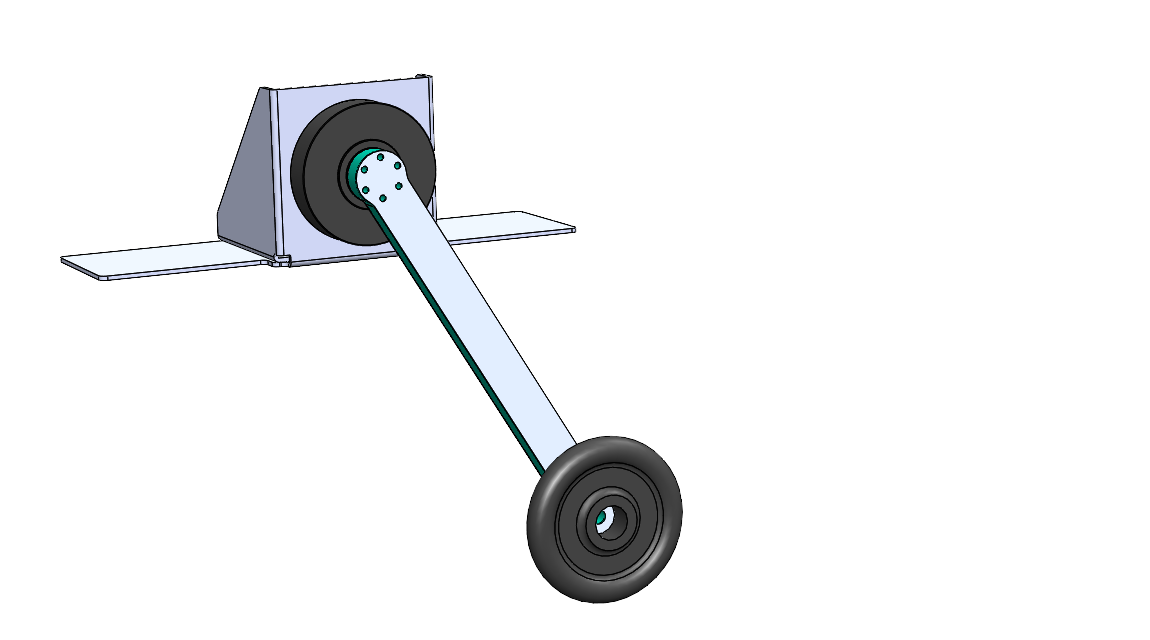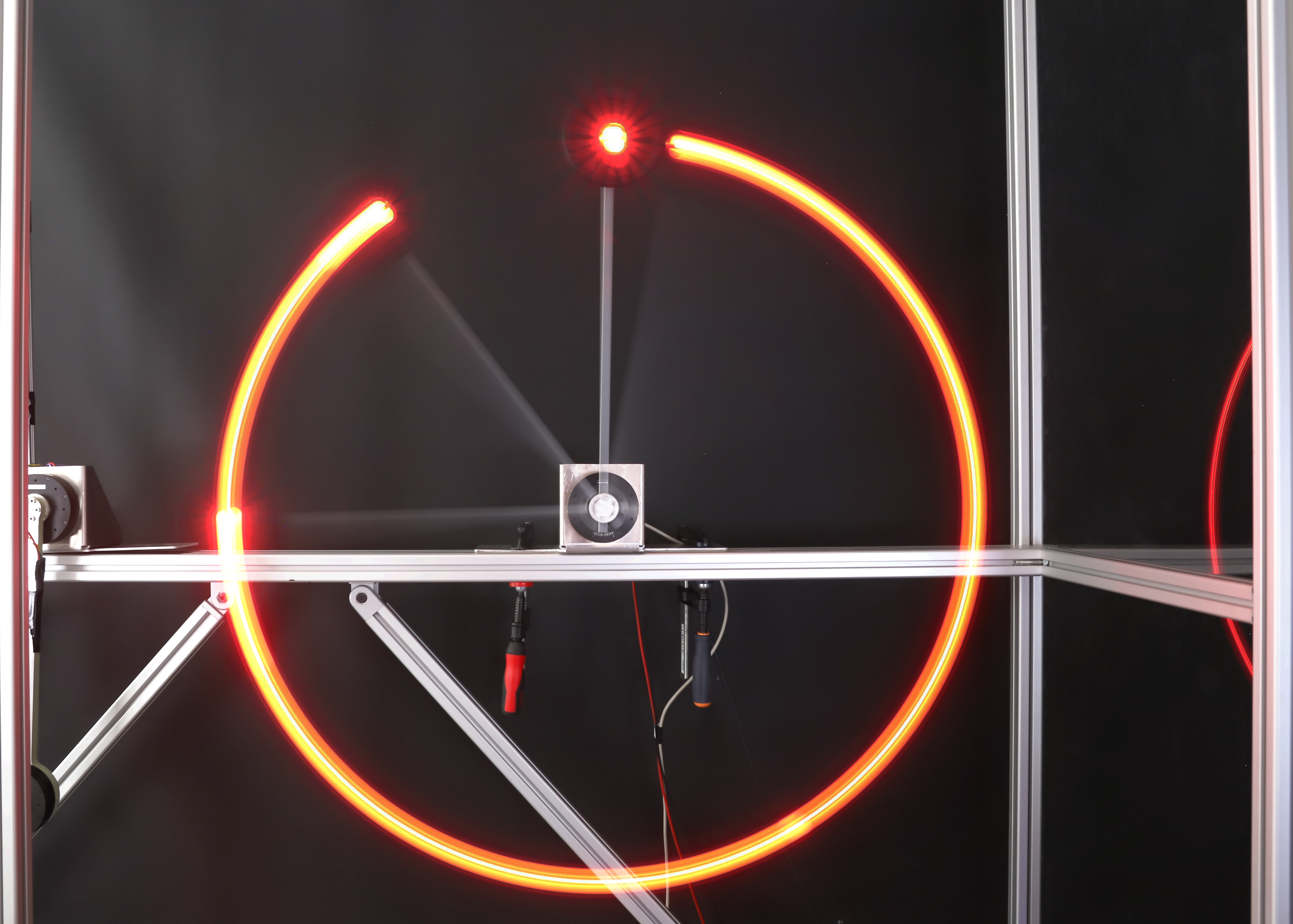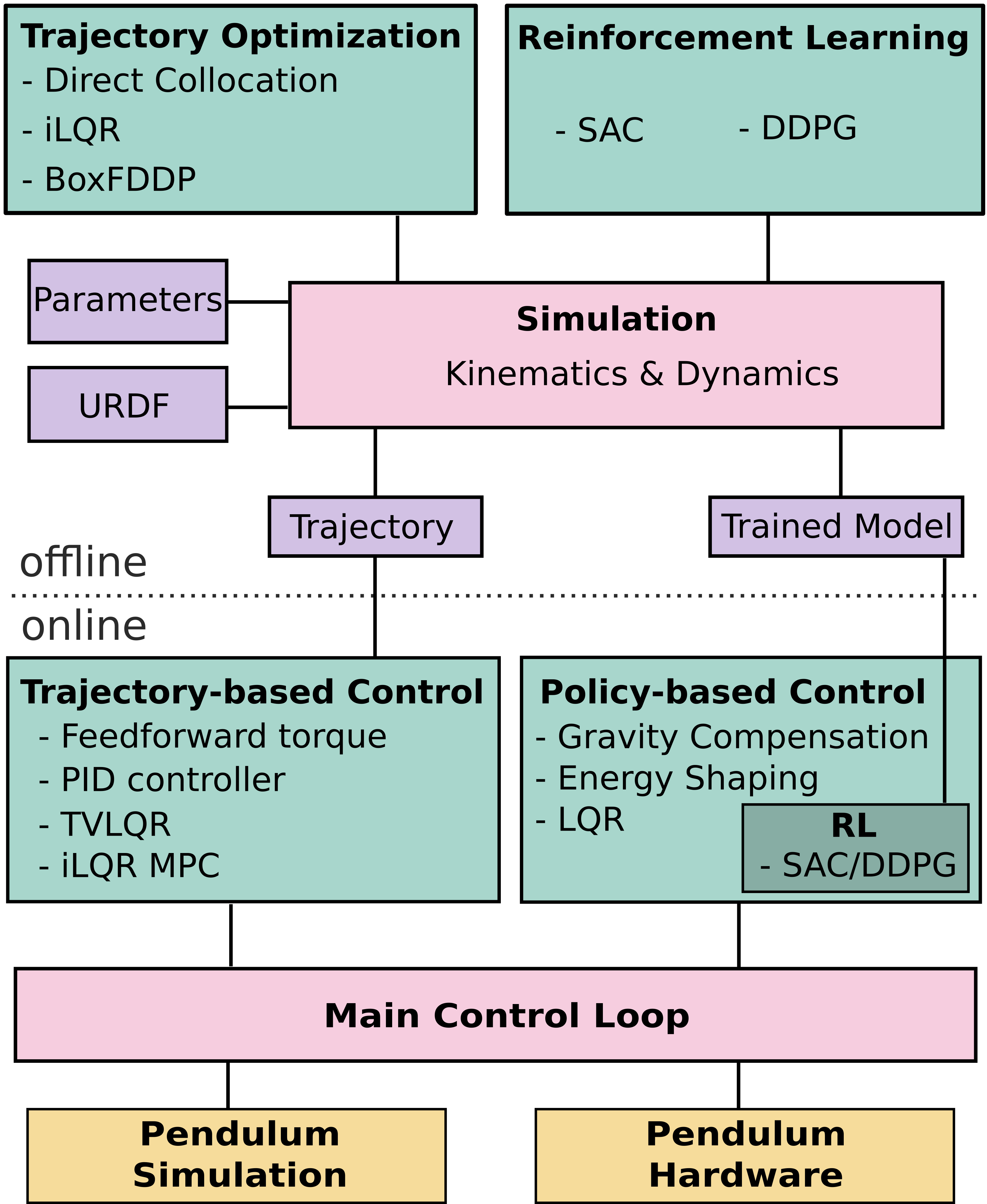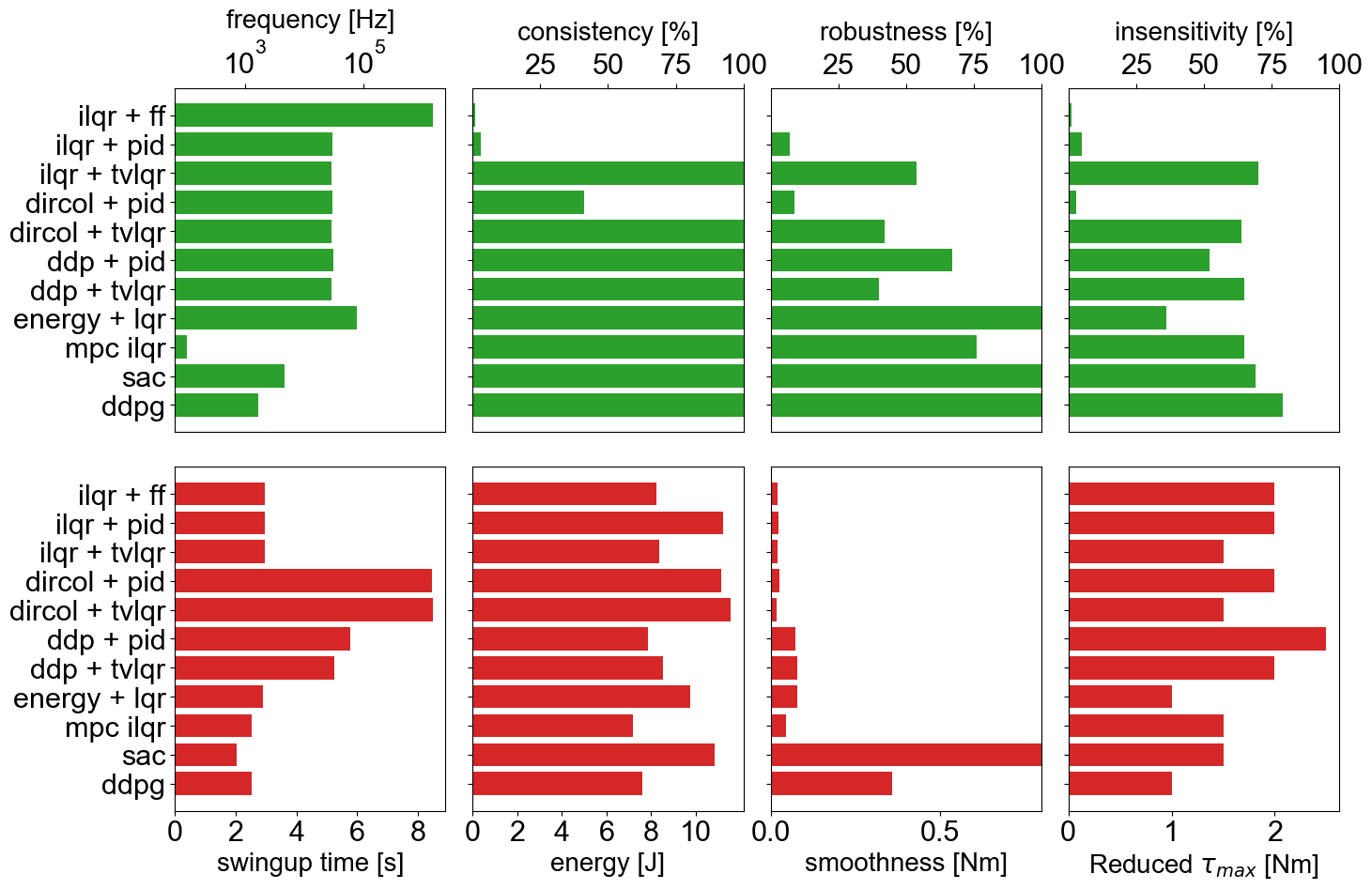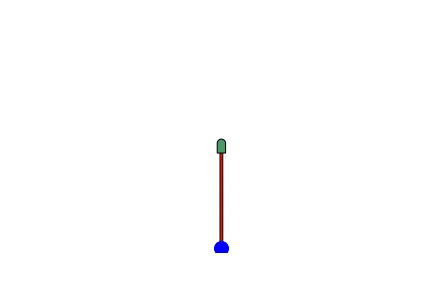The project is an open-source and low-cost kit to get started with underactuated robotics. The kit targets lowering the entry barrier for studying underactuation in real systems which is often overlooked in conventional robotics courses. It implements a torque limited simple pendulum built using a quasi-direct drive motor which allows for a low friction, torque limited setup. This project describes the offline and online control methods which can be studied using the kit, lists its components, discusses best practices for implementation, presents results from experiments with the simulator and the real system. This repository describes the hardware (CAD, Bill Of Materials (BOM) etc.) required to build the physical system and provides the software (URDF models, simulation and controller) to control it.
See the simple pendulum in action:
The full website based documentation for this repository can be found here. A pdf based printable report is available here.
As a quick start, we refer to the following readme files:
- Software Installation Guide
- Code Testing
- Pendulum Dynamics
- Hardware & Testbench Description
- Motor Configuration
- Hardware Usage Instructions
Additionally, we uploaded all CAD files to grabcad.com. You can use the 3D viewer from their webiste to diplay the 3D model directly within your browser:
If you want to install this package, you can do that by going to the directory software/python and typing::
pip install .[all]
If you want to install a minimal version without tensorflow, stable_baselines3, and drake you can do::
pip install .
For more details see Software Installation Guide.
Trajectory Optimization tries to find a trajectory of control inputs and states that is feasible for the system while minimizing a cost function. The cost function can for example include terms which drive the system to a desired goal state and penalize the usage of high torques. The following trajectory optimization algorithms are implemented:
- Direct Collocation: A collocation method, which transforms the optimal control problem into a mathematical programming problem which is solved by sequential quadratic programming. For more information, click here
- Iterative Linear Quadratic Regulator (iLQR): A optimization algorithm which iteratively linearizes the system dynamics and applies LQR to find an optimal trajectory. For more information, click here
- Feasability driven Differential Dynamic Programming (FDDP): Trajectory optimization using locally quadratic dynamics and cost models. For more information about DDP, click here and for FDDP, click here
The optimization is done with a simulation of the pendulum dynamics.
Reinforcement Learning (RL) can be used to learn a policy on the state space of the robot, which then can be used to control the robot. The simple pendulum can be formulated as a RL problem with two continuous inputs and one continuous output. Similar to the cost function in trajectory optimization, the policy is trained with a reward function. The following RL algorithms are implemented:
- Soft Actor Critic (SAC): An off-policy model free reinforcement learning algorithm. Maximizes a trade-off between expected return of a reward function and entropy, a measure of randomness in the policy. reference
- Deep Deterministic Policy Gradient (DDPG): An off-policy reinforcement algorithm which concurrently learns a Q-function and uses this Q-function to train a policy in the state space. reference
Both methods, are model-free, i.e. they use the dynamics of the system as a black box. Currently, learning is possible in the simulation environment.
Trajectory-based Controllers act on a precomputed trajectory and ensure that the system follows the trajectory properly. The trajectory-based controllers implemented in this project are:
- Feed-forward torque Controller: Simple forwarding of a control signal from a precomputed trajectory.
- Proportional-Integral-Derivative (PID): A controller reacting to the position error, integrated error and error derivative to a precomputed trajectory.
- Time-varying Linear Quadreatic Regulator (tvLQR): A controller which linearizes the system dynamics at every timestep around the precomputed trajectory and uses LQR to drive the system towards this nominal trajectory.
- Model predictive control with iLQR: A controller which performs an iLQR optimization at every timestep and executes the first control signal of the computed optimal trajectory.
Feedforward and PID controller operate model independent, while the TVLQR and iLQR MPC controllers utilize knowledge about the pendulum model. In contrast to the others, the iLQR MPC controller optimizes over a predefined horizon at every timestep.
Policy-based Controllers take the state of the system as input and ouput a control signal. In contrast to trajectory optimization, these controllers do not compute just a single trajectory. Instead, they react to the current state of the pendulum and because of this they can cope with perturbations during the execution. The following policy-based controllers are implemented:
- Gravity Compensation: A controller compensating the gravitational force acting on the pendulum. The pendulum can be moved as if it was in zero-g.
- Energy Shaping: A controller regulating the energy of the pendulum. Drives the pendulum towards a desired energy level.
- Linear Quadratic Regulator (LQR): Linearizes the dynamics around a fixed point and drives the pendulum towards the fixpoint with a quadratic cost function. Only useable in a state space region around the fixpoint.
All of these controllers utilize model knowledge. Additionally, the control policies, obtained by one of the RL methods, fall in the category of policy-based control.
The implementations of direct collocation and TVLQR make use of drake, iLQR makes use of the symbolic library of drake or sympy, FDDP makes use of Crocoddyl, SAC uses the stable-baselines3 implementation and DDPG is implemented in tensorflow. The other methods use only standard libraries.
The controllers can be benchmarked in simulation with a set of predefined criteria.
Region of Attraction (ROA) This project also provides various tools (simulation based, sums of square, analytical) for computing the region of attraction of a torque limited simple pendulum for time invariant LQR (fixed point) and time varying LQR controllers (trajectory tracking). The LQR ROA results can be found here and TVLQR ROA results can be found here. Experimental verification on the hardware is documented here. The analytical estimation of LQR ROA was reported in our CDC 2022 paper.
- Shivesh Kumar (Project Supervisor)
- Felix Wiebe (Software Maintainer)
- Jonathan Babel (Hardware Maintainer)
- Federico Girlanda (SOS, Simulation based ROA)
- Lukas Gross (Analytic ROA Estimation)
- Daniel Harnack (RL controllers)
- Heiner Peters (System Design)
- Shubham Vyas (Control Experiments)
- Melya Boukheddimi (FDDP)
- Mihaela Popescu (Filters)
Feel free to contact us if you have questions about the test bench. Enjoy!
- Fork it (https://github.com/yourname/yourproject/fork)
- Create your feature branch (
git checkout -b feature/fooBar) - Commit your changes (
git commit -am 'Add some fooBar') - Push to the branch (
git push origin feature/fooBar) - Create a new Pull Request
See Contributing for more details.
When working with a real system be careful and mind the following safety measures:
-
Brushless motors can be very powerful, moving with tremendous force and speed. Always limit the range of motion, power, force and speed using configurable parameters, current limited supplies, and mechanical design.
-
Stay away from the plane in which pendulum is swinging. It is recommended to have a safety net surrounding the pendulum in case the pendulum flies away.
-
Make sure you have access to emergency stop while doing experiments. Be extra careful while operating in pure torque control loop.
This work has been performed in the VeryHuman project funded by the German Aerospace Center (DLR) with federal funds (Grant Number: FKZ 01IW20004) from the Federal Ministry of Education and Research (BMBF) and is additionally supported with project funds from the federal state of Bremen for setting up the Underactuated Robotics Lab (Grant Number: 201-001-10-3/2021-3-2).
This work has been released under the BSD 3-Clause License. Details and terms of use are specified in the LICENSE file within this repository. Note that we do not publish third-party software, hence software packages from other developers are released under their very own terms and conditions, e.g. Stable baselines (MIT License) and Tensorflow (Apache License v2.0). If you install third-party software packages along with this repo ensure that you follow each individual license agreement.
- Wiebe et al., (2022). Torque-limited simple pendulum: A toolkit for getting familiar with control algorithms in underactuated robotics. Journal of Open Source Software, 7(74), 3884, https://doi.org/10.21105/joss.03884
@article{Wiebe2022,
doi = {10.21105/joss.03884},
url = {https://doi.org/10.21105/joss.03884},
year = {2022},
publisher = {The Open Journal},
volume = {7},
number = {74},
pages = {3884},
author = {Felix Wiebe and Jonathan Babel and Shivesh Kumar and Shubham Vyas and Daniel Harnack and Melya Boukheddimi and Mihaela Popescu and Frank Kirchner},
title = {Torque-limited simple pendulum: A toolkit for getting familiar with control algorithms in underactuated robotics},
journal = {Journal of Open Source Software}
}
- L. Gross, L. Maywald, S.Kumar, F. Kirchner, C. Lüth, "Analytic Estimation of Region of Attraction of an LQR Controller for Torque Limited Simple Pendulum," 2022 61st IEEE Conference on Decision and Control (CDC), 2022.
@INPROCEEDINGS{2022_Gross_analytic_roa_cdc,
author={Gross, Lukas and Maywald, Lasse and Kumar, Shivesh and Kirchner, Frank and Lüth, Christoph},
booktitle={2022 61st IEEE Conference on Decision and Control (CDC)},
title={Analytic Estimation of Region of Attraction of an LQR Controller for Torque Limited Simple Pendulum},
year={2022},
volume={},
number={},
pages={},
doi={}}
